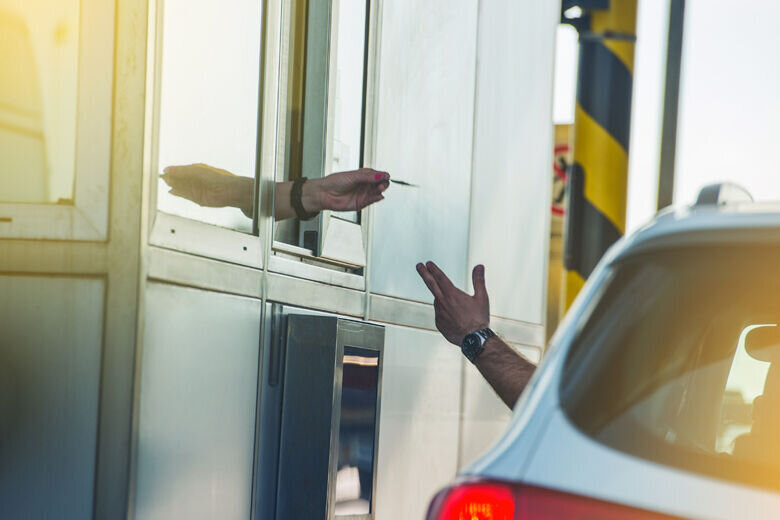This article was republished with permission from WTOP’s news partners at Maryland Matters. Sign up for Maryland Matters’ free email subscription today.

A blue ribbon transportation panel is poised to recommend new fees for electric vehicles and increased tolls as part of an effort to solve a revenue shortage plaguing the state’s Transportation Trust Fund.
The Transportation Revenue and Infrastructure Needs Commission was briefed on both possibilities Monday. An interim report due to the General Assembly by the end of the year could include both recommendations to lawmakers and the Maryland Department of Transportation.
Frank Principe, chair of the panel sometimes called the TRAIN Commission, said the recommendations “are just some of the pieces of the puzzle.”
“There’s clearly some urgency around what needs to be done,” he said in an interview.
The panel will continue to work through 2024 on other related issues including recommendations on improving the process by which state transportation officials select and prioritize projects.
Maryland Transportation Secretary Paul Wiedefeld has crisscrossed the state in recent months highlighting a six-year consolidated transportation plan. The budget document outlines projected spending on transportation projects for the state, counties and the city of Baltimore.
Those projects are paid for through the state’s Transportation Trust Fund — a dedicated pot of money that includes revenues from the state’s current 47-cents per gallon gas tax, new vehicle taxes and the bi-annual vehicle registration fees.
But those revenue sources are struggling to keep pace with growing transportation needs. Motor fuel tax collections are diminishing due to more fuel-efficient vehicles and increased adoption of electric vehicles.
People are also keeping their cars longer, which drives down tax collections on new vehicles.
The state’s current six-year transportation project plan as presented, however, faces a $100 million shortfall in fiscal 2025. At the end of the sixth year of the proposal, that gap grows to $2.1 billion.
The 10-year shortfall is projected to be nearly $4 billion, according to a recent report by legislative budget analysts.
Wiedefeld, in early testimony both before the commission and last week with a legislative panel, stressed that the plan currently doesn’t include new projects such as the Red Line.
“I do want to make the point again, that things that we talked about today are potential pieces to the puzzle, but these ideas alone are not going to solve the fiscal hole that the secretary has spoken so eloquently about in the coming fiscal year,” said Principe. “The Commission won’t be able to solve the problems of this year’s [Consolidated Transportation Plan]. I know that the department is anxious to also share with us and the public what they’re going to do in terms of balancing the current CTP. So that, I expect, will be a forthcoming conversation.”
Wiedefeld and the department are already under growing pressure from lawmakers and some local jurisdictions who are unhappy with the current unbalanced proposal.
This is the first year the agency has ever proposed an unbalanced transportation spending plan.
On Friday, members of the House Appropriations Committee’s Subcommittee on Transportation and Environment expressed frustration over the state of the spending plan. Many questioned when the agency would present a finalized, balanced plan that county leaders and residents could view and comment on.
“Basically, under state law, we need to present you with a balanced budget in January,” Weidefeld told the committee.
Subcommittee Chair Del. Courtney Watson (D-Howard) said Friday that releasing a balanced plan in mid-January would prevent counties and constituents participating in the process.
“If they don’t find out about that until the budget is introduced, that’s not a good process,” said Watson. “That’s not not enough time for them to react to talk to you. I can see it being a complete disaster, in terms of the legislative session. So, we really want those impacts on current projects to be known in December, ASAP, so that individual counties have time to react, citizens have time to comment, and people aren’t caught off guard.”
Watson and others worried Wiedefeld’s timeline would put the onus on the legislature to make decisions on transportation projects.
“We are not the experts in transportation, MDOT is and so we look to you to make the decisions and we will help you make sure that the public is aware of them so that they can provide feedback,” Watson said.
Registration fees on electric, hybrid vehicles on the table
The TRAIN commission’s interim report will be finalized next month.
That report will likely set the stage for debate in the coming session about a fee on electric vehicle registrations in Maryland.
“I think it has to be based on what we heard today,” said Sen. Pamela Beidle (D-Anne Arundel). Beidle, the incoming chair of the Senate Finance Committee, attended her first commission meeting Monday. She replaces Sen. Melony Griffith (D-Prince George’s) who left the Senate to lead the Maryland Hospital Association.
Any new registration fee on electric and hybrid vehicles will need to be passed by the legislature.
More than 137,000 zero emission vehicles, a category that includes battery electric vehicles, are expected on Maryland roads in 2024, according to a study performed by the Maryland Department of Transportation.
By 2031, that number is expected to jump to more than 1.3 million — roughly 26% of the nearly 5.1 million light duty passenger cars and trucks in the state.
The increase coincides with Democratic Gov. Wes Moore’s announcement in March that committed the state to require all new cars sold in the state to be electric vehicles by 2035.
The vehicles are heavier and cause more wear and tear on roads than standard gas-powered vehicles. But currently, owners of electric vehicles do not contribute to the state’s Transportation Trust Fund beyond the initial taxes and vehicle registration.
Sen. Stephen S. Hershey Jr., (R-Upper Shore) said a fee on electric and hybrid vehicles may have some support from Republicans.
“This was a nonstarter for the Hogan administration,” said Hershey. “He was not going to sign a bill that was going to increase fees, even though I think that it could be considered a user fee or a matter of fairness. Those vehicles should be paying some equitable amount as gasoline-fired vehicles. I think it would be something that would be under discussion, but from what I’m hearing, I think you would see bipartisan support.”
The idea is not new. Thirty-three states have imposed some form of fee on both electric or hybrid vehicles or both. Eleven others including Maryland have proposed such fees but have yet to pass them. Just six — Connecticut, Delaware, Massachusetts, Nevada, New York and Rhode Island — have yet to propose or enact such a fee.
The commission’s interim report may not include a recommended fee level.
The national average for electric vehicles is $128. Hybrid vehicle fees on hybrid vehicles run about $63 on average.
Georgia charges the highest fees at $210.87 for either category.
California, which has nearly 880,000 electric and hybrid vehicles on the road, raises the most revenue nearly $64.3 million in 2021. That state charges $108 on an electric vehicle and $11 on a hybrid.
Toll increase proposal could pinch out-of-state drivers
The panel will also consider a recommendation to increase tolls at the state’s nine toll facilities.
In September, Joseph Sagal, then the director of the Maryland Transportation Authority, said the agency that manages the toll facilities was already contemplating increases.
Sagal died unexpectedly on Oct. 26. His funeral was held Monday.
At least two options for toll increases have emerged. The first is a flat increase on all vehicles. Another option is a tiered model where out-of-state drivers may pay more.
The commission was briefed by legislative analysts on the possible effects of a flat rate increase.
Under one scenario, the state could increase revenue by more than $81.4 million by increasing tolls by 50 cents on all vehicles. Revenue would increase by nearly $89 million if the state increased tolls by 25 cents per axel, according to analysts.
Roughly one-third of the 162.8 million transactions at state toll facilities involved out-of-state vehicles.
Imposing a flat 50-cent increase on those vehicles would increase toll revenues by more than $26.7 million. A 25-cent-per-axel increase would boost state toll revenues by nearly $31.6 million on those same vehicles, according to the analysts’ projections.
Currently, money collected from tolls is set aside to pay the bonds issued for projects at Maryland Transportation Authority facilities. The increases could be funneled into the trust fund.
“So, we’ve reached the bad ideas category of this,” said Hershey, adding that the commission should also reconsider farebox collections on mass transit.
“Before we start looking at raising the gas tax, before we start looking at raising tolls, I think that needs to be on the table,” he said.
But other states including New York and Virginia use toll revenues for transportation projects, according to House Environment and Transportation Chair Del. Marc Korman (D-Montgomery).
Maryland already offers a discount on tolls for drivers with an E-ZPASS account registered in Maryland.
The legality of tolls levied on out-of-state drivers is a matter of debate.
In Rhode Island, a federal judge declared unconstitutional a plan to charge tolls to out-of-state truckers while exempting state businesses and cars registered in the state. The state has appealed the ruling and is awaiting a decision by the First Circuit Court of Appeals.
The commission is seeking advice from the Office of the Attorney General.
“We’ve asked the attorney general,” said Principe. “It’s something that’s being pursued.”








